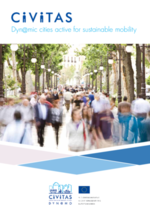Development and adoption of sustainable Urban Mobility Plan
Summary
Koprivnica has a long tradition of implementing sustainable mobility measures in the framework of the Local Agenda 21. In July 2015 Koprivnica’s SUMP was approved by the City Council, after an intensive process with stakeholders from regional and national level, including public participation and thorough cooperation between all municipal departments. The overall aim of the SUMP is to improve traffic safety while reducing noise and air pollution by promoting walking, cycling, public transport and electric vehicles.A SUMP competence centre ensures transfer of knowledge in Croatia and South-Eastern Europe.
Implementing sustainable mobility
According to a survey before the DYN@MO, the overall modal shift in the town centre was 57% vs. 43% but commuter transport is less sustainable (70% vs. 30%). The lack of public transport was seen as the main obstacle for improvement which could only be achieved by improved planning and stakeholder engagement at the regional, national and trans-boundary level.
By developing a SUMP, the city developed a mobility policy that met people’s needs, guaranteed accessibility for all and reduced the negative environmental impact of transport. The existing Koprivnica Transport Study as well as the Local Agenda 21 and the Covenant of Mayors’ Sustainable Energy Action Plan provided important input for the development of the SUMP. Successful development of local mobility strategies and implementation of measures based on the Local Agenda 21 has improved the local transport sustainability.
The innovative aspect of SUMP development in Koprivnica was the engagement of a wider community of stakeholders at the regional and national level, and involving them in the preparation and discussion. Furthermore, the development of a SUMP resulted in know-how, creating a SUMP competence centre for the wider international region.
The main objectives of this measure were to:
- Develop a Sustainable Urban Mobility Plan (SUMP) in a participatory process involving citizens and stakeholders
- Establish a local policy framework for long-term spatial and transport development
- Establish a local and regional transport strategy based on cooperation between different levels of authority as well as with relevant stakeholders of urban mobility (incl. freight traffic to and from the industrial sites)
- Anticipate future mobility needs based on public participation and prepare timely solutions in accordance with technological advances
- Include the needs of sensitive social groups into the long-term transport solutions
- Promote the new spatial and transport planning methodology in the region, fostering cooperation at regional and cross-border level in the common effort of developing future sustainable mobility solutions
- Implement new ambitious mobility solutions based on the adopted planning document
- Use the opportunity of the CIVITAS network to include foreign experts’ inputs into SUMP preparation
Progress
The City of Koprivnica has developed and implemented its own sustainable mobility measures following the strategies adopted at the local level. Two four-year programmes of sustainable transport called “Town on the move” and “Streets for people” and the development of the Local Agenda 21 have included elements similar to a SUMP, such as public participation in decision-making processes referring to sustainable transport.
To prepare for the work on SUMP the following tasks have been performed:
- Defining basic timeline
- Determination of potential relevant stakeholders in the process, including sensitive social groups, businesses and industry partners, authorities and media
- Organization of City Authority’s SUMP team
- Presentation of the concept to all stakeholders and agreement on the work plan
In the implementation phase the following tasks have been executed:
- Analysis of the mobility situation and development of options
- Organisation of the workshops with stakeholders
- Screening and reviewing of current transport situation in the view of two possible scenarios “business-as-usual” and “desirable outcomes”
- Defining of the common vision, objectives and targets as well as the scope of measures
- Development of SEE SUMP competence centre web platform and action plan
- The following tasks were executed during the stages of implementation
- Attribution of responsibilities, funds and other resources necessary for the development of the plan
- Adoption by City Council
- Presentation of the plan to the wider public
- Training for the implementation of measures
- Implementation of measures following the action plan
- Monitoring of the implementation process
- Establishment of an SUMP competence centre as part of the learning and training activity
Outcomes
Tangible outputs:
- 10 workshops with stakeholders
- 8 awareness campaigns for the public
- Status analysis produced
- Draft SUMP presented to Transport Forum for further discussion and elaboration of the action plan
- SUMP submitted to the City Council to be adopted
- SUMP action plan published
- SUMP Manual for regional use developed
- SUMP competence centre established
Expected outcomes in the short- to medium-term:
- Innovative planning practices in the municipal authority
- Public debate on the current transport situation
- Draft of SUMP produced and presented to the public
Expected outcomes in the mid- to long-term:
- Regional SUMP competence centre developed
- Increased modal shift towards public transport by 15%
- Increased proportion of walking and cycling
- SUMP competence centre promoting the development of SUMPs at the regional level









